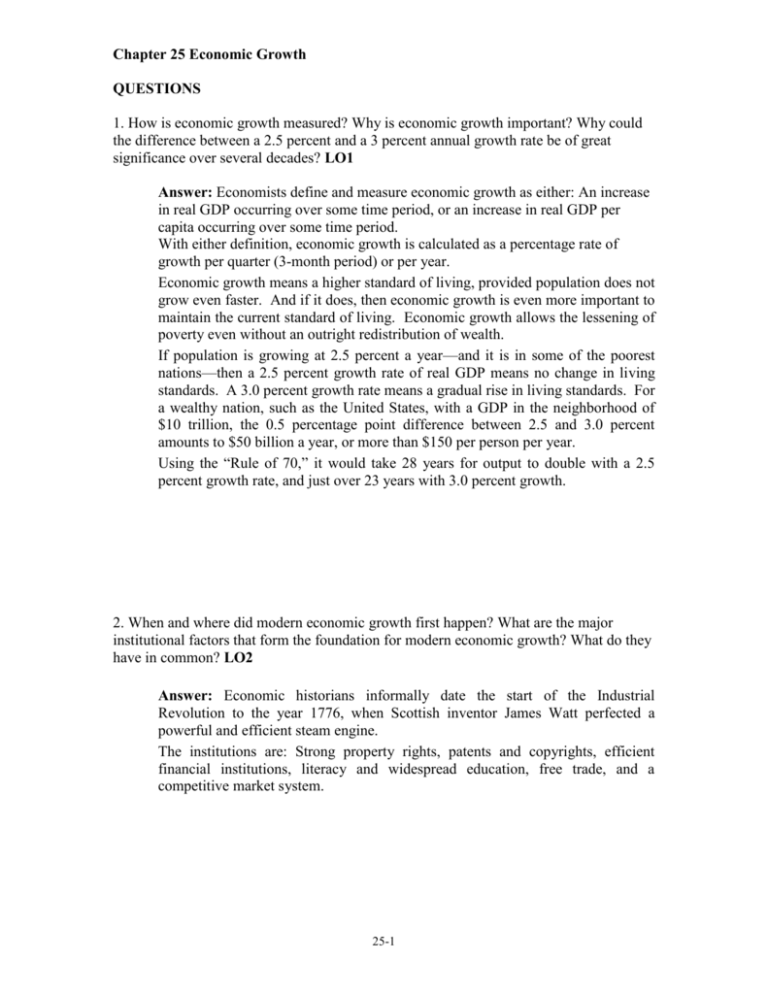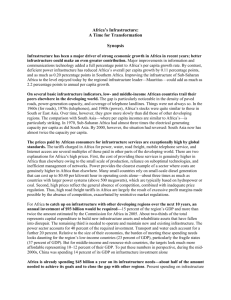CH 25 Homework Answer KEY.doc
advertisement

Chapter 25 Economic Growth QUESTIONS 1. How is economic growth measured? Why is economic growth important? Why could the difference between a 2.5 percent and a 3 percent annual growth rate be of great significance over several decades? LO1 Answer: Economists define and measure economic growth as either: An increase in real GDP occurring over some time period, or an increase in real GDP per capita occurring over some time period. With either definition, economic growth is calculated as a percentage rate of growth per quarter (3-month period) or per year. Economic growth means a higher standard of living, provided population does not grow even faster. And if it does, then economic growth is even more important to maintain the current standard of living. Economic growth allows the lessening of poverty even without an outright redistribution of wealth. If population is growing at 2.5 percent a year—and it is in some of the poorest nations—then a 2.5 percent growth rate of real GDP means no change in living standards. A 3.0 percent growth rate means a gradual rise in living standards. For a wealthy nation, such as the United States, with a GDP in the neighborhood of $10 trillion, the 0.5 percentage point difference between 2.5 and 3.0 percent amounts to $50 billion a year, or more than $150 per person per year. Using the “Rule of 70,” it would take 28 years for output to double with a 2.5 percent growth rate, and just over 23 years with 3.0 percent growth. 2. When and where did modern economic growth first happen? What are the major institutional factors that form the foundation for modern economic growth? What do they have in common? LO2 Answer: Economic historians informally date the start of the Industrial Revolution to the year 1776, when Scottish inventor James Watt perfected a powerful and efficient steam engine. The institutions are: Strong property rights, patents and copyrights, efficient financial institutions, literacy and widespread education, free trade, and a competitive market system. 25-1 3. Why are some countries today much poorer than other countries? Are today’s poor countries destined to always be poorer than today’s rich countries? If so, explain why. If not, explain how today’s poor countries can catch or even pass today’s rich countries. LO2 Answer: The reason we see such stark differences in income per capita is because of modern economic growth. The countries that began the modern economic growth process sooner, the ‘leader’ countries, have moved away from the countries that started the process later (or still have not started the process). The reason why some countries started the growth process sooner is still debated, but some common institutions tend to be the primary catalyst (property rights, education, efficient financial institutions, and free trade). The poorer countries are not destined to always be poor. It is thought that if these countries can develop the appropriate institutions, which may be country specific, they can take advantage of the pre-existing technologies and catch-up with the wealthier countries of the world. An example of this is South Korea. 4. What are the four supply factors of economic growth? What is the demand factor? What is the efficiency factor? Illustrate these factors in terms of the production possibilities curve. LO3 Answer: The four supply factors are the quantity and quality of natural resources; the quantity and quality of human resources; the stock of capital goods; and the level of technology. The demand factor is the level of purchases needed to maintain full employment. The efficiency factor refers to both productive and allocative efficiency. Figure 25.2 illustrates these growth factors by showing movement from curve AB to curve CD. 5. Suppose that Alpha and Omega have identically sized working-age populations but that total annual hours of work are much greater in Alpha than in Omega. Provide two possible reasons for the difference. LO3 Answer: One explanation might be that Omega’s labor force is underemployed, producing at a point inside the production possibilities curve. Another explanation could be that the two populations have different attitudes and preferences about work and leisure with Omega workers placing a higher value on leisure than those in Alpha. 25-2 6. What is growth accounting? To what extent have increases in U.S. real GDP resulted from more labor inputs? From greater labor productivity? Rearrange the following contributors to the growth of productivity in order of their quantitative importance: economies of scale, quantity of capital, improved resource allocation, education and training, technological advance. LO4 Answer: Growth accounting is a procedure that decomposes the supply-side elements into its different components. Primarily increases in work hours and increases in labor productivity (these components me decrease as well). The U.S. labor force grew by an average of about 1.7 million workers per year for the past 52 years, and this explains some of the growth in real GDP. The remainder, and the majority since at least 1995, is from productivity growth. Refer to Table 25.3. Other factors have also been important (contributing through productivity improvements). Factor importance in descending order: (1) Technological advance—the discovery of new knowledge that results in the combining of resources in more productive ways. (2) The quantity of capital. (3) Education and training. (4) Economies of scale and (5) improved resource allocation. 7. True or false? If false, explain why. LO4 a. Technological advance, which to date has played a relatively small role in U.S. economic growth, is destined to play a more important role in the future. b. Many public capital goods are complementary to private capital goods. c. Immigration has slowed economic growth in the United States. Answer: (a) The first part is false because technology has played the most important role in U.S. economic growth of any growth factor. However, the second part of the statement is probably true. (b) True. (c) False; immigration has been a source for an expanded labor force and also for expansion in aggregate demand. 8. Explain why there is such a close relationship between changes in a nation’s rate of productivity growth and changes in its average real hourly wage. LO5 Answer: The average real hourly wage represents the average purchasing power that each worker receives. Purchasing power refers to the amount of output that can be obtained with that wage. If output per worker is not increasing, then the amount of output available per capita for workers to buy will not be growing either. In other words the “real” wage changes only if there is an increase in productivity. Nominal wages don’t represent purchasing power. 25-3 9. Relate each of the following to the recent increase in the trend rate of productivity growth: LO5 a. Information technology b. Increasing returns c. Network effects d. Global competition Answer: The rate of productivity growth has grown substantially due to innovations using microchips, computers, new telecommunications devices and the Internet. All of these innovations describe features of what we call information technology, which connects information in all parts of the world with information seekers. New information products are often digital in nature and can be easily replicated once they have been developed. The start-up cost of new firms and new technology is high, but expanding production has a very low marginal cost, which leads to economies of scale – firms’ output grows faster than their inputs. Network effects refer to a type of economy of scale whereby certain information products become more valuable to each user as the number of buyers grows. For example, a fax machine is more useful to you when lots of other people and firms have one; the same is true for compatible word-processing programs. Global competition is a feature of the New Economy because both transportation and communication can be accomplished at much lower cost and faster speed than previously which expands market possibilities for both consumers and producers who are not very limited by national boundaries today. 10. What, if any, are the benefits and costs of economic growth, particularly as measured by real GDP per capita? LO6 Answer: Critics of growth say industrialization and growth result in pollution, global warming, ozone depletion, and other environmental problems. These adverse negative externalities occur because inputs in the production process reenter the environment as some form of waste. Critics of growth also argue that there is little compelling evidence that economic growth has solved sociological problems such as poverty, homelessness, and discrimination. The primary defense of growth is that it is the path to the greater material abundance and higher living standards desired by the vast majority of people. Growth also enables society to improve the nation’s infrastructure, enhance the care of the sick and elderly, provide greater access for the disabled, and provide more police and fire protection. 25-4 PROBLEMS 1. Suppose an economy’s real GDP is $30,000 in year 1 and $31,200 in year 2. What is the growth rate of its real GDP? Assume population is 100 in year 1 and 102 in year 2. What is the growth rate of real GDP per capita? LO1 Answer: 4%; 1.96% Feedback: Consider the following example. Suppose an economy’s real GDP is $30,000 in year 1 and $31,200 in year 2. What is the growth rate of its real GDP? Assume that population is 100 in year 1 and 102 in year 2. What is the growth rate of real GDP per capita? The growth rate of the economy's real GDP equals 4% (=( ($31,200 $30,000)/$30,000) x 100). To determine the growth rate of real GDP per capita we first need to find real GDP per capita for each (= real GDP/population). real GDP per capita year 1 = $30,000/100 = $300 real GDP per capita year 2 = $31,200/102 = $305.88 Thus, the growth rate of the economy's real GDP per capita equals 1.96% (=( ($305.88 - $300)/$300) x 100). 2. What annual growth rate is needed for a country to double its output in 7 years? In 35 years? In 70 years? In 140 years? LO1 Answers: 10; 2; 1, 0.5. Feedback: Consider the following examples (values). What annual growth rate is needed for a country to double its output in 7 years? In 35 years? In 70 years? In 140 years? The “Rule of 70,” which is to divide 70 by the rate of growth, gives us the time it takes for a country to double its output. Years to double = (70 / Rate of Growth) Rearranging this equation Rate of Growth = (70 / Years to double) The annual growth rate needed for a country to double its output in 7 years is 10% (= 70/7). The annual growth rate needed for a country to double its output in 35 years is 2% (= 70/35). The annual growth rate needed for a country to double its output in 70 years is 1% (= 70/70). The annual growth rate needed for a country to double its output in 140 years is 0.5% (= 70/140). 25-5 3. Assume that a “leader country” has real GDP per capita of $40,000, whereas a “follower country” has real GDP per capita of $20,000. Next suppose that the growth of real GDP per capita falls to zero percent in the leader country and rises to 7 percent in the follower country. If these rates continue for long periods of time, how many years will it take for the follower country to catch up to the living standard of the leader country? L02 Answer: 10 years. Feedback: Consider the following example. Assume that a “leader country” has real GDP per capita of $40,000, whereas a “follower country” has real GDP per capita of $20,000. Next suppose that the growth of real GDP per capita falls to zero percent in the leader country and rises to 7 percent in the follower country. If these rates continue for long periods of time, how many years will it take for the follower country to catch up to the living standard of the leader country? The “Rule of 70,” which is to divide 70 by the rate of growth, gives us the time it takes for a country to double its output. Years to double = (70 / Rate of Growth) Since the rate of growth for real GDP per capita is 7% in the follower country, the country's real GDP per capita will double every 10 years. So, in 10 years the follower country's real GDP per capita will be $40,000 given its current level of $20,000. The rate of growth for real GDP per capita in the leader country is 0% (no growth). Thus, it will remain at $40,000 real GDP per capita. Combining the two results above, it will take 10 years for the follower country to catch-up with the leader country. 25-6 4. Refer to Figure 25.2 and assume that the values for points a, b, and c are $10 billion, $20 billion, and $18 billion respectively. If the economy moves from point a to point b over a 10-year period, what must have been its annual rate of economic growth? If, instead, the economy was at point c at the end of the 10-year period, by what percentage did it fall short of its production capacity? LO3 Answers: 7 percent; 10 percent. Feedback: Consider the following example. Refer to Figure 25.2 and assume that the values for points a, b, and c are $10 billion, $20 billion, and $18 billion respectively. If the economy moves from point a to point b over a 10-year period, what must have been its annual rate of economic growth? If, instead, the economy was at point c at the end of the 10-year period, by what percentage did it fall short of its production capacity? The “Rule of 70,” which is to divide 70 by the rate of growth, gives us the time it takes for a country to double its output. Years to double = (70 / Rate of Growth) Rearranging this equation Rate of Growth = (70 / Years to double) Since the economy doubles its output in 10 years the rate of growth over this period was 7% (= 70/10). If actual production is at point c, $18 billion, inside the production possibilities curve output is falling short of production capacity by 10% (= $2 billion (amount short) / $20 billion). 25-7 5. Suppose that work hours in New Zombie are 200 in year 1 and productivity is $8 per hour worked. What is New Zombie’s real GDP? If work hours increase to 210 in year 2 and productivity rises to $10 per hour, what is New Zombie’s rate of economic growth? LO4 Answer: Real GDP = $1600; Rate of growth = 31.25% Feedback: Consider the following example. Suppose that work hours in New Zombie are 200 in year 1 and productivity is $8 per hour worked. What is New Zombie’s real GDP? If work hours increase to 210 in year 2 and productivity rises to $10 per hour, what is New Zombie’s rate of economic growth? New Zombie’s real GDP in a given year equals hours worked multiplied by productivity. New Zombie’s real GDP in year 1 equals $1600 (= 200 x $8). New Zombie’s real GDP in year 2 equals $2100 (= 210 x $10). We now use these values to find the rate of economic growth. New Zombie's rate of economic growth equals 31.25% ( = (($2100 $1600)/$1600) x 100)). 25-8 6. The per-unit cost of an item is its average total cost (= total cost/quantity). Suppose that a new cell phone application costs $100,000 to develop and only $.50 per unit to deliver to each cell phone customer. What will be the per-unit cost of the application if it sells 100 units? 1000 units? 1 million units? L05 Answers: $1000.50; $100.50; $.60. Feedback: Consider the following example. The per-unit cost of an item is its average total cost (= total cost/quantity). Suppose that a new cell phone application costs $100,000 to develop and only $.50 per unit to deliver to each cell phone customer. What will be the per-unit cost of the application if it sells 100 units? 1000 units? 1 million units? What will be the per-unit cost of the application if it sells 100 units? Total Cost = $100,000 + 100 x $0.50 = $100,050 Per-Unit Cost = ($100,000 + 100 x $0.50)/100 = $100,000/100 + $0.50 = $1000 + $0.50 = $1000.50. What will be the per-unit cost of the application if it sells 1000 units? Total Cost = $100,000 + 1000 x $0.50 = $100,500 Per-Unit Cost = ($100,000 + 1000 x $0.50)/1000 = $100,000/1000 + $0.50 = $100 + $0.50 = $100.50. What will be the per-unit cost of the application if it sells 1,000,000 units? Total Cost = $100,000 + 1,000,000 x $0.50 = $600,000 Per-Unit Cost = ($100,000 + 1,000,000 x $0.50)/1,000,000 = $100,000/1,0000,000 + $0.50 = $0.10 + $0.50 = $0.60. 25-9







